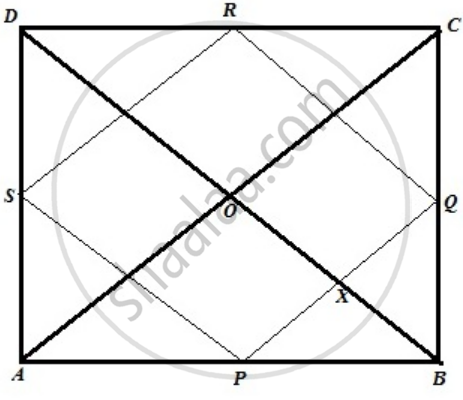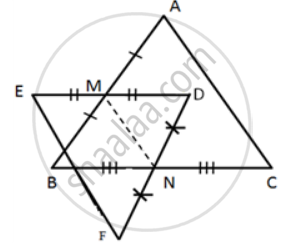Advertisements
Advertisements
प्रश्न
The diagonals of a quadrilateral intersect at right angles. Prove that the figure obtained by joining the mid-points of the adjacent sides of the quadrilateral is rectangle.
उत्तर
The figure is shown below

Let ABCD be a quadrilateral where P, Q, R, S are the midpoint of AB, BC, CD, DA. Diagonal AC and BD intersect at a right angle at point O. We need to show that PQRS is a rectangle
Proof:
From and ΔABC and ΔADC
2PQ = AC and PQ || AC …..(1)
2RS = AC and RS || AC …..(2)
From (1) and (2) we get,
PQ = RS and PQ || RS
Similarly, we can show that PS=RQ and PS || RQ
Therefore PQRS is a parallelogram.
Now PQ || AC, therefore ∠AOD = ∠PXO = 90° ...[ Corresponding angel ]
Again BD || RQ, therefore ∠PXO = ∠RQX = 90° ...[ Corresponding angel]
Similarly ∠QRS = ∠RSP = ∠SPQ = 90°
Therefore PQRS is a rectangle.
Hence proved.
APPEARS IN
संबंधित प्रश्न
In Fig. below, BE ⊥ AC. AD is any line from A to BC intersecting BE in H. P, Q and R are
respectively the mid-points of AH, AB and BC. Prove that ∠PQR = 90°.

Fill in the blank to make the following statement correct:
The triangle formed by joining the mid-points of the sides of a right triangle is
Prove that the figure obtained by joining the mid-points of the adjacent sides of a rectangle is a rhombus.
In the given figure, M is mid-point of AB and DE, whereas N is mid-point of BC and DF.
Show that: EF = AC.
The following figure shows a trapezium ABCD in which AB // DC. P is the mid-point of AD and PR // AB. Prove that:
PR = `[1]/[2]` ( AB + CD)

In triangle ABC, D and E are points on side AB such that AD = DE = EB. Through D and E, lines are drawn parallel to BC which meet side AC at points F and G respectively. Through F and G, lines are drawn parallel to AB which meets side BC at points M and N respectively. Prove that: BM = MN = NC.
D, E and F are the mid-points of the sides AB, BC and CA of an isosceles ΔABC in which AB = BC. Prove that ΔDEF is also isosceles.
Side AC of a ABC is produced to point E so that CE = `(1)/(2)"AC"`. D is the mid-point of BC and ED produced meets AB at F. Lines through D and C are drawn parallel to AB which meets AC at point P and EF at point R respectively. Prove that: 4CR = AB.
In a parallelogram ABCD, E and F are the midpoints of the sides AB and CD respectively. The line segments AF and BF meet the line segments DE and CE at points G and H respectively Prove that: EGFH is a parallelogram.
D, E and F are the mid-points of the sides BC, CA and AB, respectively of an equilateral triangle ABC. Show that ∆DEF is also an equilateral triangle.
